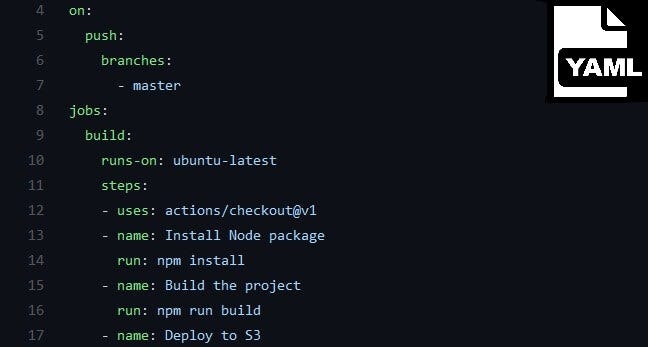This content originally appeared on Bits and Pieces - Medium and was authored by Advait Ranade
YAML — Yikes, Another Minute Lost! How Dealing with YAML Files is Hindering Developer Productivity

That was a Joke! The real full form of YAML is Yet Another Markup Language, it’s a popular data serialization language used in a wide variety of contexts, including software development, configuration management, and data interchange. In the context of software development, YAML is often used to define configuration files for applications and services, including Kubernetes applications.

While YAML files are ubiquitous in the world of Kubernetes and other modern software development practices, there are some drawbacks to relying too heavily on them. In this article, we’ll explore why focusing on YAML files can be time-consuming and bad for developer productivity, and offer some strategies for working more efficiently and effectively with YAML and other types of configuration files.
First, it’s important to understand why YAML files are so prevalent in the world of Kubernetes and other modern software development practices. The main reason is that they provide a standardized, human-readable format for defining configuration data. YAML files are easy to read and write, even for non-technical team members, and they can be version-controlled and managed just like any other code.
However, there are several reasons why focusing on YAML files can be detrimental to developer productivity. Here are a few key factors to consider:
- YAML[3][4] files can be complex and error-prone: While YAML is generally considered to be a simple and easy-to-read format, it can become quite complex when used to define complex configurations for Kubernetes applications. YAML files can be challenging to comprehend, and there’s a high probability of making errors while dealing with them. As a result, troubleshooting configuration problems can consume significant time and effort, leading to wastage.
- YAML files can be time-consuming to write and maintain: Writing YAML files from scratch can be a time-consuming and error-prone process, especially when defining complex configurations. This can be a particular challenge for teams that are working with multiple Kubernetes applications or managing large-scale infrastructure.
- YAML files can be difficult to manage at scale: As the number of YAML files in a project grows, it can become increasingly difficult to manage and maintain them. This can lead to inconsistencies, duplication of effort, and wasted time spent tracking down configuration issues.
- YAML files can be a bottleneck for collaboration: When teams are working with YAML files, it’s often necessary to review and approve changes to those files before they can be deployed. This can lead to delays and bottlenecks in the deployment process, as team members wait for approvals and updates to be made.

So, given these challenges, what can developers do to work more efficiently and effectively with YAML and other configuration files? Here are a few strategies to consider:
- Use tools to simplify the process: Several tools are available that can help in streamlining the task of managing YAML files. For example, some tools provide templates and wizards to help generate YAML files for common configurations, while others offer code completion and syntax highlighting to make it easier to write and edit YAML files.
- Use version control to manage YAML files: Version control systems like Git can be used to manage YAML files just like any other code. This can make it easier to collaborate on configurations, track changes over time, and manage conflicts when multiple team members are working on the same file.
- Use a higher-level abstraction layer: Instead of working directly with YAML files, some teams prefer to use a higher-level abstraction layer that simplifies the process of defining configurations. For example, tools like Helm provide a templating engine and package manager for Kubernetes applications, which can help reduce the complexity of YAML files.
- Automate configuration management: Automation tools like Ansible and Terraform can be used to automate the process of configuring and deploying Kubernetes applications. This can help reduce the amount of time spent managing YAML files and other configuration data, while also reducing the risk of errors and inconsistencies.
Conclusion
YAML is a popular data serialization format that is widely used in the developer community. While it has many benefits, including its simplicity and ease of use, it also has some downsides that negatively affect developer productivity. These issues can be mitigated by using the solutions mentioned above. Overall, YAML is a valuable tool for developers, and with the right solutions in place, it can be an even more productive and effective tool.
References
- https://rb.gy/o5wfjo
- https://initialcommit.com/blog/what-is-a-yaml-file
- https://www.redhat.com/sysadmin/yaml-tips
- https://kula.blog/posts/yaml/
- https://www.pngegg.com/en/png-wmqkz
Build Apps with reusable components, just like Lego

Bit’s open-source tool help 250,000+ devs to build apps with components.
Turn any UI, feature, or page into a reusable component — and share it across your applications. It’s easier to collaborate and build faster.
Split apps into components to make app development easier, and enjoy the best experience for the workflows you want:
→ Micro-Frontends
→ Design System
→ Code-Sharing and reuse
→ Monorepo
Learn more:
- How We Build Micro Frontends
- How we Build a Component Design System
- How to reuse React components across your projects
- 5 Ways to Build a React Monorepo
- How to Create a Composable React App with Bit
YAML — Yikes, Another Minute Lost! How Dealing with YAML Files is Hindering Developer Productivity was originally published in Bits and Pieces on Medium, where people are continuing the conversation by highlighting and responding to this story.
This content originally appeared on Bits and Pieces - Medium and was authored by Advait Ranade
Advait Ranade | Sciencx (2023-03-13T11:22:48+00:00) YAML — Yikes, Another Minute Lost! How Dealing with YAML Files is Hindering Developer Productivity. Retrieved from https://www.scien.cx/2023/03/13/yaml-yikes-another-minute-lost-how-dealing-with-yaml-files-is-hindering-developer-productivity/
Please log in to upload a file.
There are no updates yet.
Click the Upload button above to add an update.
